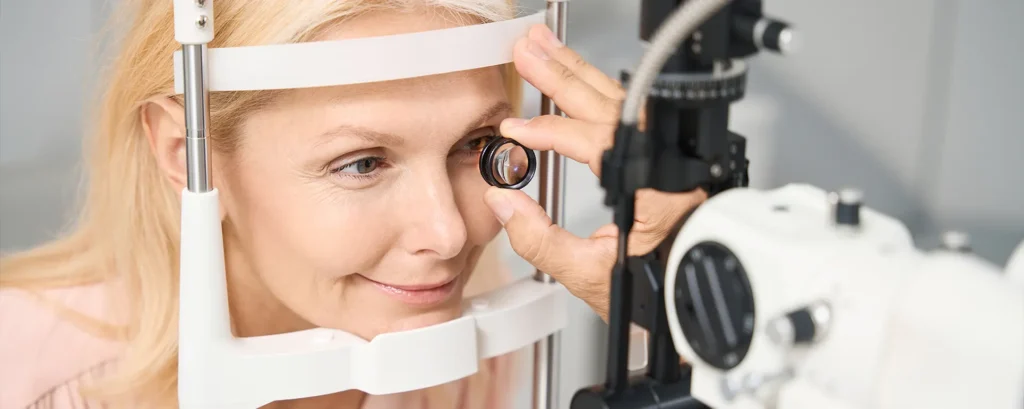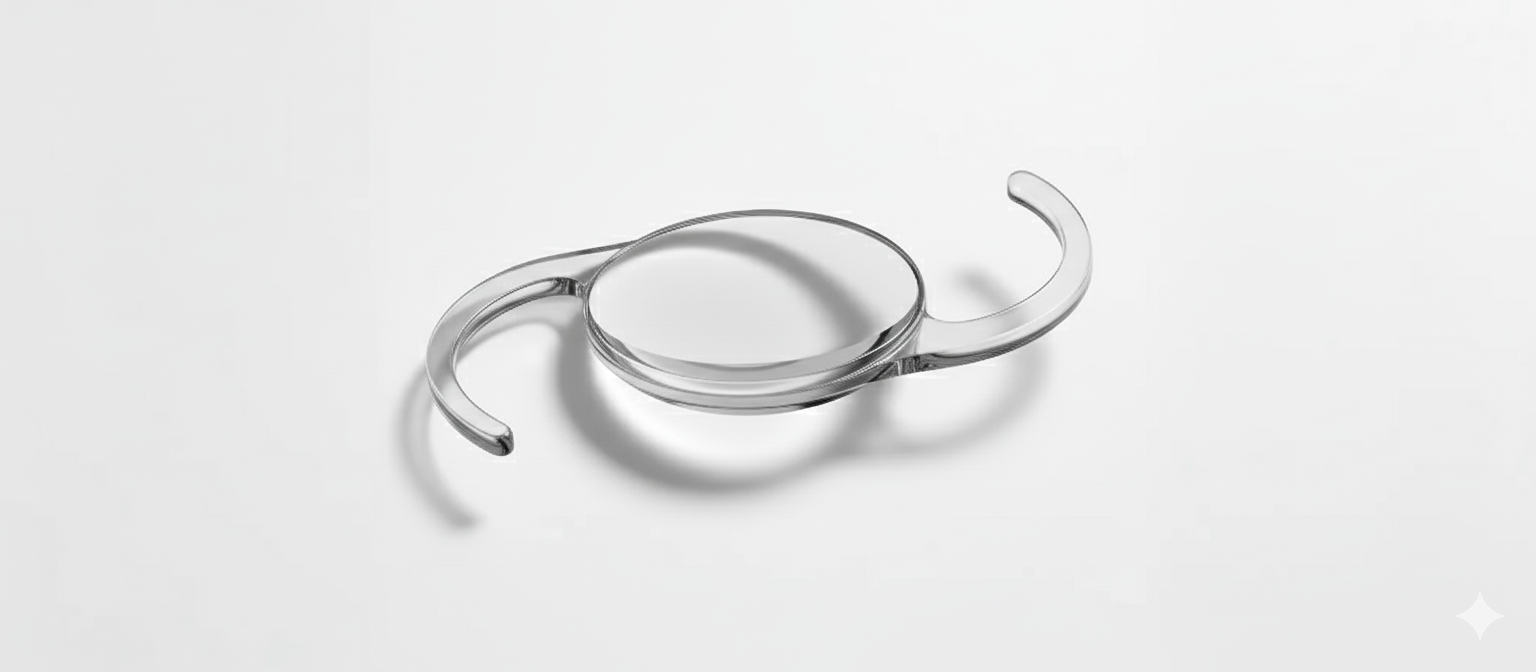Cataract surgery has already transformed millions of lives by replacing cloudy natural lenses with clear artificial ones. Today’s premium intraocular lenses (IOLs) can reduce the need for glasses, enhance contrast, improve near and distance vision, and even correct astigmatism.
But as advanced as modern IOLs are, they still rely on fixed optical power. Once your surgeon implants the lens, the focus is set. If your eyes, lifestyle, or visual tasks change, the lens cannot adapt.
That’s why researchers are now working on something extraordinary self-adjusting intraocular lenses, sometimes called “smart IOLs” or “adaptive lenses.” These lenses are being designed to automatically fine-tune focus inside the eye, using technologies such as micro-sensors, shape-changing materials, or internal fluid mechanics.
The goal is to mimic what the natural lens used to do adjust focus dynamically and deliver personalised visual optimisation throughout your life.
In this guide, I’ll explain what self-adjusting IOLs are, how they work, what technologies are currently in development, and how they may shape the future of cataract treatment at clinics like the London Cataract Centre.
Why Current IOLs Have Limitations
Before we look at future technology, it helps to understand how today’s lenses work and why we may move beyond them.
Modern IOL types include:
- Monofocal lenses
- Toric lenses (for astigmatism)
- Extended depth-of-focus lenses (EDOF)
- Multifocal lenses
- Enhanced monofocals
These lenses offer excellent results, but they share one limitation:
Their focusing power is fixed after surgery.
That means:
- You may still need glasses for reading or close work.
- Small measurement errors can leave minor refractive surprises.
- The lens cannot adapt as your eye changes with age.
- Visual demands (more screens, different working distances) cannot be automatically accommodated.
Self-adjusting IOLs aim to solve these problems by allowing the lens to change focus after implantation or continuously.
What Are Self-Adjusting Intraocular Lenses?

Self-adjusting IOLs are artificial lenses designed to modify their optical power inside the eye, either:
- automatically
- on-demand
- or via external activation
This enables the lens to fine-tune vision after surgery or throughout the patient’s lifetime.
These lenses use advanced technologies such as:
- internal micro-sensors
- liquid-filled chambers
- electro-active materials
- polymers that change shape with electrical stimulation
- light-adjustable components
- miniature adaptive optics systems
Some designs adjust only once after surgery.
Others aim to adjust continuously, replicating natural focusing (accommodation).
Why This Technology Matters
Imagine having a lens that:
- sharpens near vision when you pick up a book
- clarifies distance vision when driving
- adapts automatically to computer distance
- fine-tunes itself months or years after surgery
- adjusts if your refractive needs change
This is the promise of smart IOLs and why they represent the next frontier in personalised cataract care.
How Self-Adjusting Lenses Work: The Technology Behind the Innovation

Several different technologies are being developed. Below is a breakdown of the most promising approaches.
1. Light-Adjustable Lenses (LAL)
Already in clinical use the first wave of “adjustable” IOLs.
Unlike other smart lens concepts, LALs are already approved in many countries.
How they work
After your surgeon implants the lens, the lens power can be adjusted using UV light from a special device.
This reshapes the lens polymer, changing your prescription.
Benefits
- fine-tunes refractive error after healing
- highly accurate distance and near correction
- excellent for patients with previous LASIK or PRK
Limitations
- requires multiple UV adjustments
- not fully “self-adjusting” (needs external activation)
- still a fixed lens once the final “lock-in” treatment is done
LAL technology paved the way for “true” self-adjusting lenses.
2. Fluid-Based IOLs (Liquid Crystal or Fluid-Filled Designs)
These lenses use internal fluid that shifts within micro-channels to change shape or focus.
How they work
- The lens contains micro-chambers filled with transparent liquid.
- Small internal pumps or pressure changes shift the fluid.
- The curvature changes, altering optical power (like the natural lens).
Triggers may include:
- eye muscle movement
- electrical stimulation
- light patterns
- internal pressure sensors
Advantages
- can replicate natural accommodation
- smooth, continuous focus
- less glare or halos than multifocal designs
Challenges
- reliability of fluid movement over decades
- miniaturisation of pumps or valves
- long-term biocompatibility
Still, this approach is one of the most promising for “dynamic” focus.
3. Electro-Active or Electro-Responsive Lenses
These lenses change focus when a tiny electrical charge is applied.
How they work
- Contains electro-active polymers or liquid crystals
- Micro-electronics direct electrical fields inside the lens
- The optical shape changes instantly
Possible triggers
- blinking
- ciliary muscle activity
- eye movement
- external smart glasses or contact lens communication
Advantages
- fast focusing
- highly precise
- adaptable for all distances
Issues to overcome
- powering the lens safely
- long-term stability of internal electronics
- ensuring no heat or electromagnetic side effects
Electro-active lenses are still experimental but scientifically promising.
4. Shape-Memory Polymer Lenses
These lenses are made from special materials that “hold” different shapes depending on environmental conditions.
How they work
The lens changes its curvature when stimulated by:
- temperature
- electrical impulses
- mechanical pressure
- pH changes
Why this is exciting
Shape-memory lenses could:
- react to natural ciliary muscle movement
- provide smooth accommodation
- adjust power after healing
Current limitations
- stability
- manufacturing precision
- achieving smooth, repeatable focusing
Still, they offer a biologically inspired direction for future IOLs.
5. Sensor-Based Smart Lenses
Some prototypes contain micro-sensors that detect what you’re trying to focus on.
Sensors measure:
- pupil size
- eye movement
- brightness
- ciliary muscle tension
- focus intention
The lens then adjusts automatically.
Benefits
- more intuitive
- tailored to the user’s visual behaviour
Concerns
- complexity of internal electronics
- long-term reliability
- safety regulations
This concept is similar to autofocus in cameras but miniaturised and internal.
6. Magnetically Adjustable IOLs
Using tiny internal magnets, the lens curvature can be altered externally using a magnetic field.
How they work
- magnets inside lens
- external magnetic device adjusts lens power
- lens shape changes permanently or temporarily
These could be used to:
- fine-tune vision after surgery
- adjust as your needs change over time
Still in early development stages.
Why Do We Need Adjustable IOLs?
As our lifestyle and visual tasks evolve, so do our needs.
Modern visual challenges:
- multiple screens
- digital devices
- varied reading distances
- increased night-time driving
- longer life expectancy
A fixed-focus IOL may not always cope perfectly with these demands.
Adjustable lenses can “future-proof” your vision by adapting with you.
How Self-Adjusting Lenses Could Improve Personalisation
1. Fine-Tuning After Surgery
Even with the best scans, small refractive errors happen.
A smart lens can correct them automatically.
2. Adaptation to Lifestyle
If you switch careers or hobbies, your lens can adjust.
3. Compensation for Age-Related Changes
Your eye may change shape slightly as you age; a static lens cannot respond but a smart lens can.
4. Enhanced Near Vision Without Multifocal Side Effects
Smart lenses could give natural focus without halos or glare.
5. Adjustments for Night vs Day Vision
Some designs may optimise for light conditions.
Benefits for Patients
If these technologies become mainstream, patients may enjoy:
- clearer near and distance vision
- less dependency on glasses
- customisable focus
- better night vision
- reduced glare
- more natural visual transitions
- higher surgical precision
- long-term adaptability
It could mark the biggest leap forward since phacoemulsification.
Safety Considerations for Future Lenses
Researchers are addressing crucial safety issues such as:
- long-term implant stability
- biofilm resistance
- lens power consistency
- compatibility with MRIs and electromagnetic fields
- risk of inflammation
- internal electronics biocompatibility
- the lifetime of sensors or polymers
Regulatory approval will require extensive testing.
When Will Self-Adjusting IOLs Become Available?
Some technologies, like light-adjustable lenses, are already here.
Other fully automatic, sensor-driven, or electro-active IOLs may reach clinical use within:
- 5–10 years for early versions
- 10–20 years for fully autonomous versions
The timeline depends on regulatory approval and long-term studies.
Clinics such as the London Cataract Centre are likely to be among the first to adopt future premium IOL innovations as soon as they are proven safe.
Who Will Benefit Most From Adjustable IOLs?
Smart lenses will be especially valuable for:
1. Patients with a history of refractive surgery
(e.g., LASIK, PRK), where measurements are less predictable.
2. People who want full spectacle independence
without multifocal halos.
3. Younger cataract patients
who need flexible vision for decades.
4. People with demanding visual lifestyles
like pilots, graphic designers, or heavy computer users.
5. Patients with progressive refractive tendencies
including astigmatism or corneal irregularities.
What Will Cataract Surgery Look Like in the Future?
Cataract surgery could shift from a one-time replacement to an adaptive visual system.
- Future pathways may include:
- Implanting a base smart lens
- Adjusting it repeatedly over months
- Ongoing lens monitoring
- AI-driven optimisation
- Remote adjustments
This is personalised medicine at its finest.
Challenges Facing Smart IOL Development
While exciting, the technology must overcome:
- micro-electronic safety
- powering internal sensors
- miniaturisation
- material stability
- biocompatibility
- cost
- regulatory barriers
- long-term durability
Yet progress is accelerating each year.
FAQs:
1. What exactly are self-adjusting intraocular lenses?
Self-adjusting intraocular lenses (IOLs) are the next evolution in cataract technology, designed to modify their focusing power inside the eye after implantation. Unlike traditional fixed lenses, these “smart lenses” can automatically or externally adjust to help you see clearly at different distancesf much like the natural lens you were born with. Some use light-based adjustments, while others rely on internal micro-sensors, fluid-filled systems, or electro-active materials that change shape in response to stimuli. Their main goal is to provide lifelong personalised vision, even as your visual needs change over time.
2. How do self-adjusting lenses differ from traditional premium IOLs?
Traditional premium lenses, such as multifocal or extended depth-of-focus IOLs, are pre-set with fixed optical powers that cannot change after surgery. They improve near and distance vision, but once implanted, the focus remains constant. Self-adjusting lenses, on the other hand, introduce dynamic adaptability. They can fine-tune or recalibrate focus after implantation, offering far more flexibility. For example, if your near vision changes over time, or your visual habits shift due to work or age, a smart IOL can adapt something a standard lens simply cannot do.
3. How does a self-adjusting IOL know when to change focus?
The adjustment mechanism depends on the technology type. Some designs use internal sensors that detect what you are trying to look at by measuring eye movement, pupil size, and light levels. Others respond to external cues like UV light or magnetic fields applied by your surgeon. More advanced prototypes integrate microprocessors that interpret visual intent similar to how autofocus works in digital cameras allowing the lens to automatically shift focus from near to far in real-time. This ability to interpret your visual behaviour makes the lens “smart” in a truly practical sense.
4. Are self-adjusting IOLs already available to patients?
A few early versions of adjustable lenses, such as the Light Adjustable Lens (LAL) by RxSight, have already received regulatory approval in several countries and are being used in clinical practice. These lenses allow your surgeon to fine-tune your vision after surgery using special light treatments. However, fully autonomous, continuously adjusting lenses are still in research and development stages. Many are undergoing safety and long-term trials before they can be introduced for widespread patient use. Experts predict that more advanced, sensor-based models could become available within the next decade.
5. How does the light-adjustable lens work?
The light-adjustable lens represents the first practical step toward smart IOLs. After the cataract procedure, the patient returns for follow-up visits where the surgeon uses a controlled ultraviolet (UV) light beam to alter the lens’s internal structure. This process changes the lens’s optical power, allowing precise correction of any residual refractive error. Once the ideal vision is achieved, the lens is “locked in” with a final treatment. This offers a level of post-surgical customisation that was previously impossible, giving patients sharper vision tailored to their exact needs.
6. What are the safety concerns with self-adjusting IOLs?
Because these lenses use microelectronics, smart materials, or internal fluid systems, ensuring long-term safety is a top research priority. Scientists are studying how these materials behave inside the eye for years or even decades. Concerns include maintaining stable optical power, preventing inflammation or biofilm formation, ensuring electromagnetic compatibility (for example, during MRI scans), and avoiding internal heat or energy buildup. Regulatory authorities such as the FDA and MHRA require extensive testing before approval to confirm that smart IOLs are as safe as current standard implants.
7. Who would benefit most from a self-adjusting intraocular lens?
Patients who value long-term flexibility and precision will likely benefit the most. This includes younger cataract patients who want a solution that adapts as their vision changes, professionals with visually demanding jobs, and people who have had previous laser vision correction where traditional measurements can be less predictable. Additionally, patients seeking full independence from glasses especially those who dislike the glare or halos sometimes caused by multifocal lenses may find the adaptive capabilities of a smart IOL ideal.
8. How are these lenses powered or activated inside the eye?
Different prototypes use different power systems. Some lenses are powered externally using light or magnetism no internal battery is needed. Others use electro-active materials that respond to natural biological signals such as the contraction of the ciliary muscles (the muscles that control natural focusing). A few advanced designs are exploring micro-energy harvesting, where the lens generates small amounts of power from eye movement or temperature changes. The key challenge is creating a system that works continuously and safely without external maintenance.
9. Will cataract surgery change when self-adjusting lenses become available?
The surgery itself is unlikely to change drastically because the lens is still implanted through the same tiny incision used for modern phacoemulsification. However, the post-operative process will evolve. Patients may return for lens calibration sessions or remote adjustments using specialised devices. Future cataract surgery may become more of an ongoing visual management process, where the implanted lens can be optimised or fine-tuned over time. Clinics like the London Cataract Centre will likely lead this transition toward a more adaptive, lifelong vision-care approach.
10. What does the future of cataract treatment look like with smart IOLs?
Cataract surgery is evolving from a one-time replacement to a dynamic, intelligent vision system. In the coming years, patients could receive a base adaptive lens that continually refines focus through internal sensors or AI-guided feedback. This could allow surgeons to remotely monitor lens performance and make non-invasive adjustments when needed. Combined with advances in robotics, imaging, and data-driven medicine, self-adjusting IOLs represent the next leap in personalised eye care where every patient enjoys vision tailored to their unique needs at every stage of life.
Final Thoughts: The Future of Vision is Adaptive
Self-adjusting intraocular lenses represent one of the most exciting frontiers in modern ophthalmology. By combining the precision of digital technology with the adaptability of biological vision, these smart lenses could redefine what cataract surgery can achieve. Instead of a one-time fix, patients will soon enjoy lenses that learn, adjust, and evolve with their eyes offering sharper vision, greater comfort, and true long-term personalisation.
At the London Cataract Centre, we’re passionate about bringing the latest vision innovations to our patients. Our team follows every major development in adaptive lens technology to ensure that, when self-adjusting IOLs become available, our patients will be among the first to benefit. If you’re thinking about cataract surgery in London, get in touch with us at the London Cataract Centre to explore your options.
References:
1. Makhsatova, Z., Esteves, P., Kang, C., Ibrayeva, L. & Vieira, P., 2023. Electro-active intraocular lenses: Current advances and challenges. Sensors, 23(8), p.4126. Available at: https://www.mdpi.com/1424-8220/23/8/4126
2. Marcos, S., Sawides, L., Gambra, E. & Dorronsoro, C., 2017. Influence of adaptive optics technology on intraocular lens development and testing. Progress in Retinal and Eye Research, 56, pp.156–185. Available at: https://pubmed.ncbi.nlm.nih.gov/27856288/
3. Zhao, Y., Li, J., Li, Y., Zhang, X. & Chen, Y., 2022. Advances in smart materials for ophthalmic applications: Toward next-generation intraocular lenses. Frontiers in Bioengineering and Biotechnology, 10, Article 955784. Available at: https://pmc.ncbi.nlm.nih.gov/articles/PMC9425632/
4. Tarczy-Hornoch, K., Lin, D.T., & Wolfe, P., 2020. Dynamic focusing in accommodative intraocular lenses: A review of design concepts and prototypes. Translational Vision Science & Technology, 9(13), p.7. Available at: https://pmc.ncbi.nlm.nih.gov/articles/PMC7757139/
5. Villegas, E.A., Rubin, M., Smyth, R., & Georgescu, D., 2014. Refractive accuracy with light-adjustable intraocular lenses. Journal of Cataract & Refractive Surgery, 40(12), pp. 1993-1999. https://pubmed.ncbi.nlm.nih.gov/24957429/

